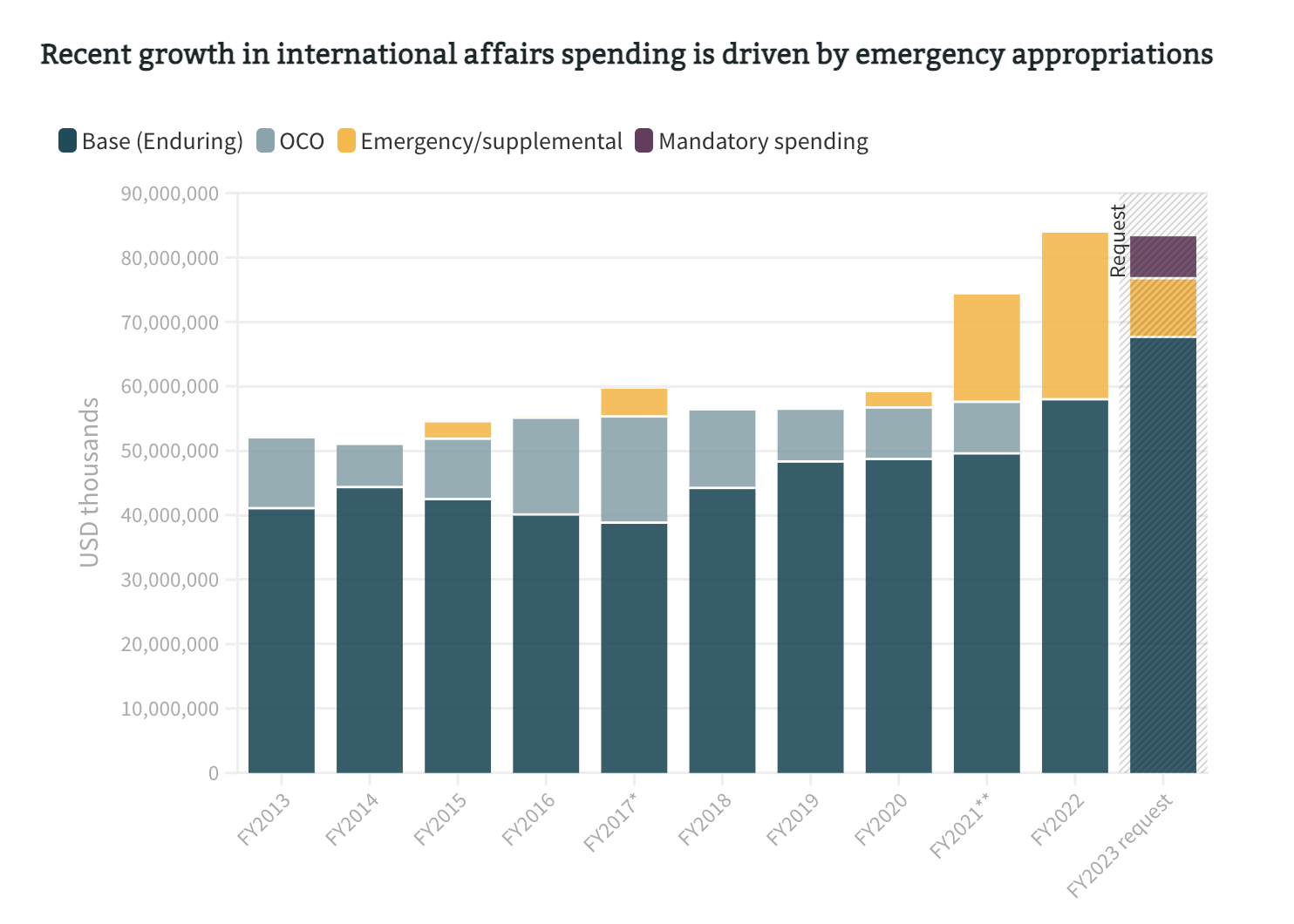Recommended

Blog Post
Ahead of the holiday break, US lawmakers reached agreement on a final FY2023 spending deal. After months of stalled negotiations, an omnibus appropriations package was far from guaranteed. But concerns about the consequences of a long-term continuing resolution—and the prospect of adding a major task requiring urgent attention to the agenda of the incoming 118th Congress—meant compromise prevailed.
The final bill—which crossed the proverbial finish line on December 29, 2022—included critical funding for US development and humanitarian priorities and further supplemental support for Ukraine. Here’s a quick rundown on how select accounts and programs fared and what it might portend for US development policy in the year (errr… 9 months) ahead.
(Figures in charts and tables below are in millions of US dollars and reflect base appropriations without any supplemental funding unless otherwise specified.)
A boost for bilateral economic assistance
The final spending package included increases for USAID’s Development Assistance and the State Department’s Economic Support Fund. These core accounts support development programming across a wide range of priorities, including efforts to promote food security—which took on a new urgency following Russia’s invasion of Ukraine.
Appropriators signaled continued support for USAID’s work to promote locally-led development, providing flexible funding for the agency’s Centroamérica Local Initiative for the second year running. But lawmakers are looking for more information from USAID on key definitions associated with the agency’s localization targets and details on local implementation and financial management.
Both Power Africa and Prosper Africa will see an increase in funding in FY23. The explanatory statement allocates $100 million for each initiative—which were featured by the administration during the December US-Africa Leaders Summit. Whether momentum from the summit will be sustained into 2023 and beyond remains an open question, but the funding boosts for these targeted initiatives and vocal support from lawmakers could help. And Prosper Africa—a holdover from the Trump administration—has new leadership to boot.
USAID’s Development Innovation Ventures—better known as DIV—also received a plus up compared to prior years. The $40 million allocated for FY23 is a new high watermark for DIV since appropriators began including a spending directive for the initiative in FY2018. The program’s approach, which involves soliciting proposals and funding innovative solutions to development challenges (ensuring rigorous evaluation along the way), has won over members on both sides of the aisle. And, legislation introduced near the end of last session aimed to codify DIV while supporting the program’s further integration in USAID operations.
Interestingly, the explanatory statement references authorization for loan guarantees to small island developing states to help them grapple with the challenges posed by climate change, but offers few details. Our colleagues have suggested revisiting US sovereign loan guarantees, an underutilized financial instrument, to address critical development challenges in select countries.
Tackling longstanding global health priorities while bolstering pandemic preparedness
Table 1: Congress gives global health programs a big boost in both USAID and State Department accounts (USD million)
Funding in the bill for global health programs administered by the State Department and USAID totaled $10.56 billion. Within State’s global health funding $2 billion is tapped for the US contribution to the Global Fund—consistent with the administration’s $6 billion pledge over three years, announced ahead of the US-hosted replenishment last year.
The measure sets aside $900 million in funding explicitly for global health security—falling short of the administration’s request—authorizing future contributions to the financial intermediary fund for pandemic preparedness (now the Pandemic Fund) and $100 million for the Coalition for Epidemic Preparedness Innovations (CEPI). Seeking to learn from challenges encountered while fighting the global COVID-19 pandemic, the administration sought $6.5 billion in mandatory funding that would have enabled substantial five-year investments in global health security—above and beyond annual discretionary spending—but the proposal failed to secure sufficient support on Capitol Hill.
The effort underscored the administration’s goal of ensuring sustained attention on bolstering pandemic preparedness while continuing to make progress toward longstanding health goals. A new plan to establish a Bureau of Global Health Security and Diplomacy at the State Department with US Global AIDS Coordinator Dr. John Nkengasong at the helm reflects this objective. Under the best scenario, increasing integration across US global health investments could reinforce shared objectives but getting the details right could prove challenging.
Covering core costs at USAID
Encouragingly, appropriators provided an increase for USAID operating expenses. In negotiations to stay within tight toplines, administrative line items can sometimes catch short shrift. But for USAID to make progress toward filling longstanding workforce gaps and advance its localization agenda, providing sufficient resources for the agency’s operational budget is critical.
MCC subject to another recission
While the Millennium Challenge Corporation (MCC) sees a slight budget increase over last year—consistent with the administration’s request—the agency’s unobligated balances are subject to an unexpected $100 million rescission. This comes of the heels of an even more substantial rescission in FY22 and could mark a worrying trend. MCC’s model hinges on multi-year grant agreements with selected partner countries, and ensuring the agency can deliver on its commitments requires careful pre-planning and depends on resources being set aside in advance. Were rescission to become a more common occurrence it could severely undermine the agency’s operations and patented approach.
Table 2: MCC faces another rescission, indicating a potential new trend
In more encouraging news, appropriators dropped a longstanding provision that barred the agency from pursuing threshold programs with countries that had already been compact partners. While the original rationale was to avoid rewarding backsliding on measures of good governance, after nearly 20 years it has the effect of prohibiting potentially beneficial partnership with countries that have experienced major government overhauls. For example, Madagascar was the first country to sign an MCC compact—which entered into force in July 2005, but was terminated early due to a military coup in 2009. Madagascar passed MCC’s FY23 scorecard for the first time in several years, suggesting the country could again be a viable partner, but under previous spending bills, MCC would have been unable to explore a threshold program with the country—which could be a logical next step.
DFC reaches $1 billion
The latest spending deal puts DFC’s budget at $1 billion—$220 million for the agency’s administrative expenses and $780 million for its program account—consistent with the president’s budget request. DFC boasts a global portfolio of well over $35 billion and an array of financing instruments that provide substantial leverage. Frustratingly, a fix to the illogical budget treatment of the agency’s direct equity authority by OMB remains elusive—putting unnecessary strain on the program budget. To help DFC to realize its full potential, with added benefit to the State and Foreign Operations topline, we hope lawmakers in the 118th Congress will advance a solution.
Support for international financial institutions presents a mixed picture
Treatment of the international financial institutions in the FY23 spending package proved something of a mixed bag. The good news is that Congress provided the increased funding for IDA requested by the administration, which will enable a final payment on the US IDA-19 commitment and a first (partial) payment toward IDA-20. This dual track payment came about because shareholders agreed to hold an early IDA-20 replenishment that mobilized additional resources to help countries respond to and recover from the COVID-19 pandemic.
The funding included in the omnibus would put the US on track to deliver on recent IDA commitments if Capitol Hill supplies level funding for the World Bank’s concessional financing window for the next two fiscal years.
And Congress belatedly provided authorization for the twelfth replenishment of the Asian Development Fund, enabling the US to channel both newly and previously appropriated funds to help meet its pledge.
But the measure does not include requested authorization needed to recycle SDRs—seemingly due to continued resistance among Republicans, including key actors in the Senate. Lawmakers also ignored (for the second time) an administration request to provide IDA with an exemption from SEC registration requirements.
As in FY22, Congress provided a more modest contribution to the Clean Technology Fund rather than the large loan envisioned by the administration. And appropriators again failed to secure bipartisan support for a contribution to the Green Climate Fund—though the bill includes no explicit prohibition on such funding.
Revised language in the explanatory statement (section 7029) underscores lawmakers’ continued interest in MDB procurement amid China’s dominance, directing US executive directors at the institutions “to promote the prioritization of the use of local labor and trade-off standards that determine best value bids, rather than lowest-price technically acceptable, including with State-owned companies and enterprises.” Our colleagues highlighted the success of Chinese firms in securing MDB contracts in an analysis of China’s evolving role in the multilateral system.
The advent of the 118th Congress could bring even greater scrutiny to China’s overseas activities—House Republicans have committed to establishing a select committee focused on China. Chinese lending practices could be an emphasis, but the dominance of Chinese firms in MDB procurement could be another subject of debate.
Base appropriations for humanitarian accounts lagging
For the second year running, Congress delivered lower base funding for humanitarian accounts than the budget request and even draft bills from earlier in the year—pointing to additional support delivered through supplementals. In this instance, the supplemental funding for Ukraine includes money for both IDA and MRA and a modest bump for food aid. We’ve pointed out that there’s some danger in this approach.
The administration also requested $100 million to help replenish the Emergency Refugee and Migration Assistance account—a no-year reserve fund that the president can draw upon to respond to urgent refugee needs. Drawdowns over the last two years, made largely in response to the situation in Afghanistan, have left the fund diminished. Still, Congress opted to provide only $100,000.
Further additional support for Ukraine
Lawmakers agreed to provide further support to Ukraine as conflict in the country (instigated by Russia’s invasion) continues. The latest round of aid includes another large injection of budget support as well as additional humanitarian assistance.
Disclaimer
CGD blog posts reflect the views of the authors, drawing on prior research and experience in their areas of expertise. CGD is a nonpartisan, independent organization and does not take institutional positions.
Image credit for social media/web: Adobe Stock





